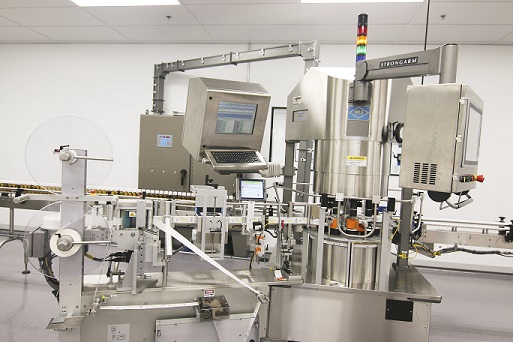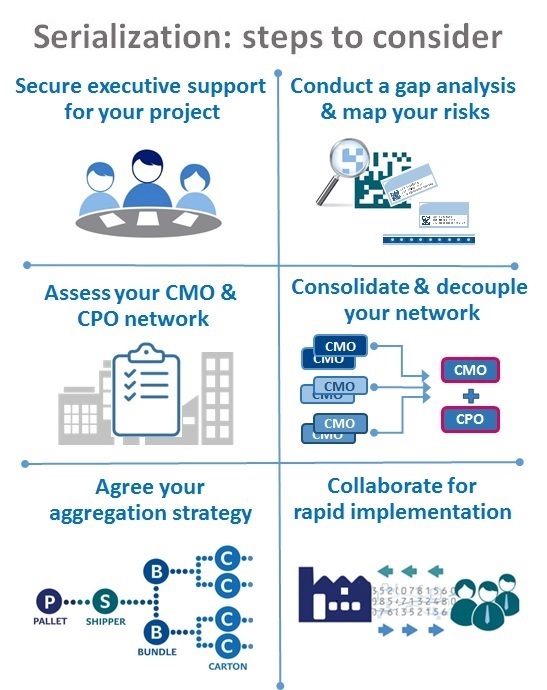Published September 2016
What are the key steps you need to consider in assessing your partner network’s readiness for serialization? Sharp’s Director of Technical Services explains.
While implementing a successful serialization strategy involves many complex and inter-dependent steps, they are not insurmountable, as early adopters are finding. Much has been written already on the tactical demands of preparing packaging lines and sites for serialized production but many pharmaceutical organizations are either unaware or underestimate one of the biggest challenges facing any serialization program: ensuring the engagement and support of executive stakeholders in each of the many functional areas required to successfully implement a serialization strategy.
The key to success involves mobilizing a cross-functional team of Engineering, IT, Technical, Project Management, Graphic Design and Quality with the support of a serialization specialist who has the necessary skills and experience for realizing a serialization project. Critically, a project of this scale requires board-level sponsorship, particularly when significant capital investment requirements are taken into account.
All this must be accomplished while facing the rapidly approaching industry deadlines – the U.S. Drug Supply Chain Security Act (DSCSA) in November 2017 and the EU Falsified Medicines Directive (EU FMD) in February 2019. With the first of those deadlines only 15 months away, it is time to move from talking to mobilizing your stakeholders if you have not already done so. This at least puts your own organization on the correct path to achieve serialization readiness.
Once your own house is in order, you then need to consider the risks in your external CDMO and CPO partner network. Even those that have the wherewithal to meet the capital demands of serialization, still need to overcome the skill set challenges and ever-increasing equipment lead times. Therefore, in addition to getting your internal support structure in place, you need to critically assess your external partners to ensure you have visibility of their path to serialization readiness and believe it is achievable.
Conduct a gap analysis and develop your blueprint
Understanding where there are gaps in your contract network will allow you to make informed decisions about the risks to business continuity in a serialized world and mitigate against them. Performing a gap analysis of your CDMOs is essential to understanding who in your network is ready for serialization. Some of those questions you should be considering include:
- Who has already developed a strategy for serialization? What is their overall capacity? What types of formats are they able to serialize? Can they take on new clients at this point? What software vendors are they using and are they compatible with your existing EPCIS system? What is their track record in putting serialization programs in place?
- Who has demonstrated the ability to assist you in optimizing the three variables in packaging and artwork – graphic/artwork placement, package structural design and the potential impact/interface on the line equipment/processing equipment – required to support serialization?
- Who of your network has won the necessary executive support to ensure timely delivery of the strategy and an internal cross-functional team of experts – IT, engineering, project management, validation, packaging design – to manage serialization implementation?
- Have they committed the capital expenditure and knowledge investment to support line level, site level and EPCIS (Enterprise level)?
- Have they a robust implementation plan?
Start-up costs can be considerable and ready access to capital is essential to ensure the timely implementation of your serialization project. How will your CDMO fund the investment necessary to install and validate serialization hardware and data transfer software? How is the CDMO sharing the capital burden with their customer base? Do they require you to make a contribution to installation costs? Many CDMOs may choose to concentrate on producing bulk product and withdraw from packaging altogether, rather than start to put costly serialization platforms in place at this stage. Does it make sense then to decouple these CDMOs from your CPOs?
Once you have mapped out your understanding of your external network’s serialization readiness by CDMO, then by their individual site, line, product and SKU – you will be in a stronger position to develop a blueprint for your strategy and therefore mitigate risk. Where gaps exist in capabilities or readiness, there are options available, but time is running out.
The opportunity for full technical transfers is diminishing fast. As regulation deadlines are looming, you will need to find partners that are serialization-ready in order to avoid potentially costly delays in your supply chain. It may make sense to continue manufacturing activities with those CMOs who do not have a tested serialization strategy, but you should seek to decouple the packaging function entirely and look to transfer to a serialization-ready packaging site.
Decouple and consolidate your network
Given the complexity of any serialization implementation, there is a distinct benefit to consolidating your CDMO/CPO network into fewer packaging and serialization hubs.
Even if all of your contract partners can serialize, does your organization have the resources and capital to support serialization implementation with them all? How many serialized partners can you sustain? Which packaging activities can easily be decoupled from bulk manufacturing for transfer into a serialization ready packaging hub? Consolidating into fewer packaging sites will offer considerable savings – both financial and resources – when starting-up serialization projects. The financial burden associated with introducing line and site level serialization systems and serialized data transfer systems is considerably lessened when using fewer packaging sites. Consolidation means that both logistical and financial demands are streamlined. Benefits of scale can also be realized with greater volume being packaged by fewer sites.
Understand the technical Infrastructure
Many organizations still believe that serialization ultimately means printing numbers on packaging. However, the complexity of that process – the convergence of physical product flow with mirrored electronic data flow – is not clearly understood. The technical infrastructure that has to be established to generate, store, capture and transmit unique serialized data, across a broad portfolio of brands, is complex and requires substantial planning. You will need to build collaborative partnerships with specialists in serialization implementations in order to support each of the unique challenges of infrastructure, data management and transfer.
The specification of serialization system architecture – both hardware and software – is critical. Many detailed decisions will need to be made about the technical infrastructure and data flow. A significant demand will be placed on IT and project management resources and it’s essential that you make available the right technical personnel to deliver your serialization program using detailed project charters and PMO practices.
Electronic Product Code Information Service (EPCIS) considerations play a large part in the overall serialization program and the data generated, so it is important to understand and plan how your serialized data will be securely communicated between you and your contract partners. There are decisions to be made on field mapping data and configuration of XML files to accommodate the portion of code that is customized.
EPCIS technology companies, such as TraceLink, enable the harmonization of data exchange between multiple parties through one cloud connection to the network. This reduces the business risk and challenges of multiple time-consuming and costly point-to-point connections. Choosing the appropriate EPCIS partner is therefore, one of the most important decisions to be made in preparing for serialization.
Data exchange and management of serialization information across the product lifecycle with supply partners are key components to enabling an agile and compliant track and trace supply chain for today’s complex and evolving serialization regulations. Selecting your serialization management partner therefore, is a strategic decision that should be made very early in your planning.
Brian Daleiden, Vice President, Industry Marketing, TraceLink
In keeping with this need for data harmonization, you should establish your user requirements to be shared with your team and partners. These will help all involved better understand what needs to be accomplished and within what timeline. These user requirements should provide an organization of what is to be serialized, including the content and the placement of the data, in addition to the data exchange specifics.
As with any form of data exchange, complications can arise immediately and serialization is no exception. Printing numbers on a package is relatively easy. However, the hardware, systems and processes behind serializing and tracing the product throughout a worldwide distribution chain are not always well understood. Again, leveraging the expertise and experience of software and hardware companies with proven solutions in the practice of global serialization and track and trace systems will ultimately save you time and money.
The technology employed for serialization and track and trace processes must be extremely robust and highly configurable to meet individual product requirements across ever-changing global regulations. As global and regional regulations evolve, it is important to be able to minimize production impacts, simplify ownership, and reduce cost of operations and validations at the customers’ local manufacturing level. Seamless integration for all data exchange is critical — from the machines to the line to the site to ERP systems to third parties. Looking ahead at upcoming global compliance changes and considerations, available technology is already providing multi-regional, multi-level aggregation to enable customers time to meet future regulations.
Jim Lee, SVP Product Management, Systech
“The pharmaceutical industry cannot afford to falter at this juncture, as too much is at stake. Companies need to draw upon proven, at-the-ready solutions to reduce their risk of failure in meeting upcoming regulatory demands and should do so with technology companies that have a track record in meeting changing requirements without burden on the user.”
Look to work with those creating the emerging standard in the industry, solution providers that have developed a rapid-onboarding plan. You may find some of your product portfolio can be serialized with established, proven standard platforms and therefore move forward more quickly while greater lead time is needed for those requiring specialized implementation.
Build in your aggregation strategy

You need to consider how your contract partner can support your future aggregation strategy now. Even though aggregation is only required in the US by the 2023 deadline, the three major players that dominate the US distribution network – McKesson, Cardinal Health and AmerisourceBergen – have each issued their mandates to manufacturers for aggregation and data exchange capability.
Why should you aggregate? Consider the complexity of moving large volumes of serialized drug product through an interconnected supply chain network. Managing the relationship between your serialization numbers and physical product through up to five layers of aggregation will be paramount for standard movement types. Then consider the added difficulty of efficiently processing movements such as returns and damages in the supply chain. You need to ensure the integrity of link from the digital to the physical product.
Your contract packaging partner should work with you to build the framework for aggregation of serialized data into your strategy now so that you are able to provide fully functioning traceability architecture in the future. Retrofitting the capacity for aggregation does not make economic or business sense given the inevitability of it in the future. Has your CMO sufficient space within their packaging cubicles to install aggregation hardware in addition to other line-level serialization devices? Can they support the incremental investment required for aggregations?
Start collaborating now for success
No matter whom you choose to be in your serialization network, it is only through collaboration, both cross-functionally inside your organization and externally with your partners, that the challenges of serialization can be successfully addressed. Mobilizing a carefully selected ‘virtual’ serialization team will deliver the most effective program to meet the compliance deadlines. Make sure your outsource partners are engaged and aware of the challenges you are facing. If they are not prepared or lack an understanding of what needs to be done, you need to acknowledge and address the risk that brings to your own organization. The serialization clock is ticking.
In establishing the collaborative team needed to successfully run serialization now, you allow yourself the flexibility to look beyond the operational challenges of compliance and consider the value and opportunities serialization regulation will provide. In so doing, you can offer more to the patient population. Avoid adverse events, optimize channel distribution and provide information to patients based on the unique data markers of their medications – all with one seemingly “simple” data mark.
The full Contract Pharma article can be downloaded here.






